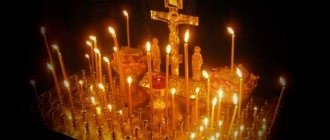Vesting (tonsure) is the main rite of initiation into monasticism. A person who takes tonsure makes several lifelong vows before the Lord, while securing Divine grace. To become a nun is always an absolutely voluntary desire; it can in no way be imposed from the outside. Let's try to understand the features of this sacred ritual in today's material.
Historical information
Followers of Jesus Christ spread his knowledge throughout the globe. People who believed them began to adhere to an ascetic lifestyle. A little later, a separate category of believers begins to unite in small groups to serve God.
Find out what awaits you today - Horoscope for today for all zodiac signs
Where and when exactly monastic tonsure arose - history has not conveyed to this day. What is known is that initially the nuns had to take a vow of celibacy, and subsequently other vows arose. When Catholics were ordained as monks, they performed a ritual called “humenzo” - a special haircut with shaving of a circle on the head.
Orthodox Christians did not adhere to such a tradition and, on the contrary, it was customary here for clergy and monks to wear long hair and beards.
"New man" versus "old man"
A priest from St. Petersburg, Sergius Shalberov, clarifies that after the sacrament of Baptism, a person’s soul is, as it were, divided into two parts. One part of it, which can conventionally be called the “new man,” strives to live according to the commandments of Christ and avoid the temptations of the world, while the second part in every possible way “slows down” the process of uniting man with God, wanting to live according to the laws of the mortal world, enjoy its benefits and temptations. The goal of the “new man,” according to the Apostle Paul, is to put away the “old man” and put on the “new man.” And monasticism in this case becomes the main “radical” path that the “new man” needs to follow in order to defeat the “old”, sinful man.
Therefore, at the rite of tonsure of a novice as a monk, the death of the “old” man and the birth of the “new man” are announced. This “new person” is given a new name.
Being tonsured a monk - what does it mean?
Often novices are equated to the angels of God. They are called "angels on earth." And, true, taking on the monastic rank is a very difficult decision, not accessible to every person.
Angels are completely selfless beings who do not seek to gain any benefit. They serve the Lord faithfully. Monks do the same. Having completed monastic tonsure, monks give their lives in full service to the Almighty.
Due to numerous requests from readers, we have prepared an “Orthodox Calendar” application for smartphones. Every morning you will receive information about the current day: holidays, fasts, days of remembrance, prayers, parables. Download for free: Orthodox Calendar 2021 (available on Android)
This ritual is often compared to the second baptism - a dramatic change in a person’s life occurs. Monasticism is, on the one hand, a feat, and on the other, an incredibly difficult mission. As a reward for all hardships, novices receive a special connection with the Lord.
On the other hand, they deprive themselves of many earthly joys and do not create a family, that is, they do not continue the human race. Every medal always has a flip side. In addition, the human Ego is a very difficult thing, which only a select few can completely overcome. Therefore, sometimes monks cannot withstand such a load and take off their vow, returning to ordinary life.
Interesting! Until the 19th century, it was not possible to renounce the monastic rank. Today it is quite possible to do this if desired.
To be tonsured a nun: steps, types of monasticism
Anyone wishing to become a nun must undergo lengthy preparation, namely:
- Be a hard worker.
- Then she can become a candidate for novitiate.
- And only then – as a novice herself.
It is possible for every Christian believer to be a worker. At this stage, a person performs certain work, helping the monastery in his free time.
Workers are not always novices; they may have a family, a worldly life. And in some cases, they even receive a salary from the monastery for their work. But if a worker decides to live at a monastery, then he must adhere to the established rules: do not violate the daily routine, give up bad habits.
A woman who wants to become a nun, upon entering the monastery, becomes a candidate for novices. Other sisters introduce her to the rules of the charter, and she must determine for herself whether she agrees to lead a strict monastic life.
Interesting! You will have to spend about 3 years as a candidate novice. But the exact period of time is established by the abbess of the monastery and the elder sisters.
If at the end of the probationary period the applicant does not change her decision to stay at the monastery, there are no external obstacles - she is enrolled as a novice. The abbess of the monastery and the candidate herself write a petition to the ruling bishop. Having received the blessing, the sister will need to undergo a special ritual of initiation into a nun.
In modern Russian Orthodoxy, three types of tonsure as a nun are used:
- Rasophorus.
- Lesser schema (otherwise known as the mantle).
- Great schema.
To take the first type of hair, the ryassophore, a woman will need to live in a monastery for at least three years. True, in some cases exceptions are made - for example, if the candidate is terminally ill and has less time to live than the allotted time for tonsure.
The ritual of tonsure as a ryassophore nun includes:
- saying special prayers;
- cutting hair in the shape of a cross;
- changing or leaving a worldly name;
- dressing in special clothes (cassock and hood);
- there are no vows.
But although this type of monasticism does not involve the use of vows, the decision to devote one’s life to God is already a very serious commitment. Ryasophor is a preparatory stage of monasticism, it is similar to betrothal before marriage. At this stage, the woman is called a nun, a ryassophore novice or a ryassophore nun. She receives God's grace, as well as the help of the holy person after whom she was named during the ritual.
It should be noted that the pattern of tonsure as a nun may vary depending on the specific monastery. So it is possible that the stage of the ryassophore is skipped, and initiation into the lesser schema is immediately carried out. And some monks on Holy Athos even accepted the great schema without prior preparation. All people are different, everyone is at a different level of spiritual development, so sometimes exceptions are made to the general rules.
The ritual of tonsure into the minor schema is already the beginning of monasticism. At this stage, the woman must make vows before the Lord, completely renounce worldly life, and she is given a new name and a special robe.
The rite of initiation into the great schema is distinguished by a special solemnity: various prayers are read for a long time, the abbot gives his instructions to the nun. Then she receives a new name and clothes, as well as a great paraman (a special scarf with sacred Christian symbols), a kukol with a pendant. Now she is called a schema-woman.
Interesting! In Russian Orthodoxy, seriously ill or elderly people are often tonsured into the Great Schema.
The ritual is performed either directly by the ruling bishop, or by other higher ranks of the clergy (abbots, hieromonks, archimandrites), but always with his permission.
tonsure practices
The order of tonsure may vary in different monasteries. In some parishes the ryassophore may be omitted - the woman is immediately elevated to the minor schema. In many monasteries there is an unspoken practice of ordaining only very elderly and terminally ill nuns into the great schema.
The Russian Orthodox Church does not adhere to a strictly defined sequence of tonsure procedures. The Church considers each person individually, paying attention to his desire to serve people and God. In some cases, women can be initiated into schema nuns without any previous work or knowledge.
To be tonsured a nun: how it happens, features of monasticism
Monasticism is not one of the main church sacraments. But a large number of priests find it for the second baptism. The tonsure symbolizes obedience and sacrifice to God. Serious monasticism begins with tonsure into the minor schema (or mantle). This ritual is longer than the previous one, the ryassophore, and more solemn. How does becoming a nun happen at this stage?
First, the troparion from the week about the prodigal son is performed. In this case, the future nun must crawl on her stomach into the central part of the temple. She is wearing a long white shirt. She should lie face down in the center of the building, with her arms outstretched in a cross shape. On either side of her are two nuns who cover the woman with their schemas.
The initial stage of the ritual is intended to remind you that monasticism is a path of crying and heartfelt repentance. Then the abbot turns to the woman, calls her to stand up, and begins to ask whether she freely makes the choice of monastic life. The abbot emphasizes that the vows made by her will be accepted by Jesus Christ himself and His Mother, as well as by all saints and angelic beings.
Then it’s time to make vows:
- the novice promises to live in the monastery (the one where the initiation takes place or another one where she will be sent);
- expresses readiness to live according to monastic rules without violating them;
- observe fasting and chastity;
- cope with the sorrow of monastic life;
- takes a vow of celibacy;
- promises to be obedient (to the abbot and other sisters);
- takes a vow of poverty.
Then the abbot instructively discusses the meaning of the monk’s life, places a book on the head of the future nun, reads prayers to guide her on the path of service, enlighten her and bestow the Grace of the Holy Spirit. In this case, the abbot will serve as the confessor of the new nun (but he can entrust this task to an experienced nun).
Afterwards, the novice must hand the abbot three times specially thrown scissors from the floor - thereby confirming that her choice is voluntary. This is followed by a cross-shaped haircut, and the nun is told her new name (usually in honor of the holy person on whose day she was born).
Victor is the winner
– Father, did you expect to receive the name Victor in tonsure? Who were you named after? Enlighten us a little.
- In honor of the martyr Victor of Damascus. I guessed what the name might be, but had no definite preferences. For me, the main thing was not the name, but the tonsure for which I was preparing, the awareness of the importance and seriousness of such a change in my life.
– What is known about your patron saint?
– Not much, but there is still little information about Victor of Damascus, and even that information is contradictory. Since 1906, his relics have been located in the Italian city of Fano. I have hope that the Lord will deign to visit there someday and venerate the incorruptible remains of my heavenly patron. Immediately after tonsure, one monastery governor gave me a small piece of the relics of the martyr Victor as a gift, and another priest close to me gave me an ancient icon of the saint, into which I placed the relics. This shrine is located in my holy corner, where I pray to my Angel every day.
– Is anything known about the death of the martyr?
– The Christian warrior Victor (from Greek “winner”) suffered martyrdom for Christ in the middle of the 2nd century in Damascus for refusing to worship the pagan gods. By human standards, the death of the saint was very difficult. He was thrown into a hot oven, where he remained unharmed for three days, forced to eat poisoned meat, his veins were pulled out, thrown into a cauldron of boiling oil, hung on a tree and his body was scorched with candles. Then they gouged out his eyes, tore off his skin and beheaded him, after which a miracle happened: blood and milk flowed from his body. The saint's memory is celebrated annually on November 24. By the way, in the paintings of the Kyiv St. Sophia Cathedral there is one of the ancient images of the martyr Victor (1st half of the 11th century).
Who can and who cannot become a nun?
It is important to know some formalities if you want to become a nun. Indeed, in some cases you will be forced to refuse. Which ones exactly?
- If you are officially married. People with happy family relationships are not accepted into the monastery (and they are unlikely to have such a desire).
- If you are single but have minor children. According to the rules of the Russian Orthodox Church, it is unacceptable to take children with you to the monastery, because monasticism is only a voluntary decision of a person. It cannot be imposed by anyone.
- If you have unresolved problems of a family, property or legal nature.
As a rule, a woman can become a nun once she reaches the age of thirty. If she still has minor children, then she will need to issue a certificate of guardianship for them.
Remember that becoming a nun is a very serious and responsible step; people do not come to it just like that, guided by immediate motives. The decision to devote oneself to God must be carefully considered and stand the test of time. Only then can it be considered correct.
Chief Vow
– What is the main vow of a monk?
– The monk promises God to maintain chastity, non-covetousness and obedience. These are the three pillars on which the entire monastic life is built. A person who is completely devoted to the vow of obedience has a much easier life. If you do something of your own free will, the result is disastrous. It seems like I did everything right, but something is missing. For a monk, being obedient is the basis of life.
– Do you know the feeling of loneliness? Didn't it get worse in monasticism?
– I once had a conversation with His Beatitude Metropolitan Vladimir. We talked about choosing a life path. I was 23 years old then. I said that it was somehow alarming to realize that a monk remains alone for the rest of his life. Vladyka told me not to worry about this, because I would never be alone. God is always with a monk, and He will send the people he needs at a certain stage of life. I always remember these words, even the facial expression and emotions with which His Beatitude spoke them. And now, 10 years later, I find confirmation of what was said in my own life. The Lord sends me a sufficient number of wonderful people, some of them open up to me in a new way. A person should not be deprived of communication. But the most important thing is harmony in communication with God.
– What habits did you have to give up when you became a monk? What did you leave behind in your past life?
– In monasticism, I realized the seriousness of self-discipline. It is very important to have the right and firm attitude in life. After tonsure, Bishop Rector Metropolitan Anthony presented me with the Fatherland Book of St. Ignatius Brianchaninov with a dedicatory signature and a short wish: “Always remember your monastic vows.” These words should run like a red thread in the life of a monk. When a person relaxes, even a little, he stops feeling the fall. And having fallen, he realizes that he should have woken up earlier. There will be temptations in any case, because the life of a monk is a constant struggle with oneself, with one’s thoughts. The monk must conquer himself. I always remember the expression of our Primate, His Beatitude Metropolitan Onuphry: “We must be strict with ourselves and merciful towards others.”
– How do you deal with feelings of self-pity?
– When I analyze all my thoughts, actions and deeds, I don’t feel sorry for myself. I never try to find fault in another person, but I look for it in myself. Sometimes thoughts are aimed at self-justification, but they must be suppressed, because the enemy, in subtle interpersonal relationships, tries to sow enmity and misunderstanding, which then turns into anger and bitterness. You cannot think about sinful thoughts; they must be stopped at their inception.







